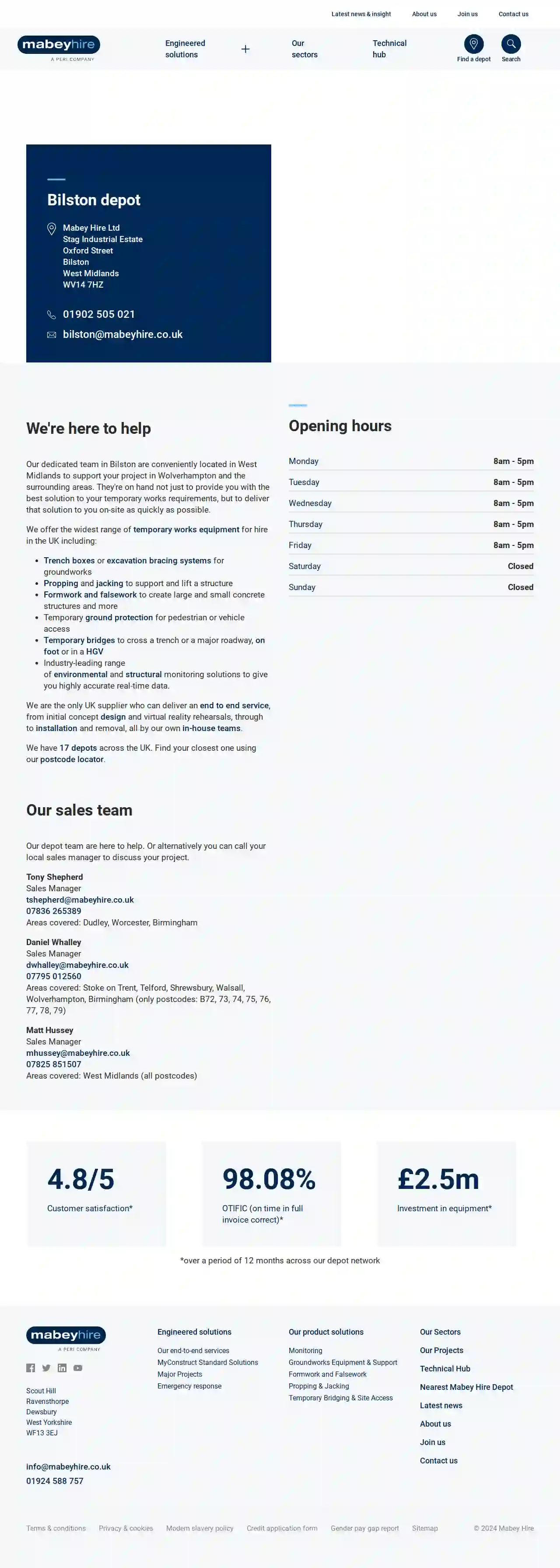Excavation Contractors Wolverhampton
Top 10 Land Excavation in Wolverhampton
Receive up to 3 Excavation Companies quotes for your project today! Compare profiles, reviews, accreditations, portfolio, etc... and choose the best offer.

JMS Grab Hire & Aggregates
55 reviewsUnit 24/25 Monmore Rd, Wolverhampton, WV1 2TZ, GBJMS Ground Services JMS Ground Services is a family run business offering Skip Hire, Grab Lorry Hire & Ground Works to Wolverhampton, Dudley and the surrounding areas. With over 20 years experience in the industry, we offer quality work at competitive rates. Our skillset includes excavation, drainage, footings, waste removal, muck away, thrust boring and much more. With a passion for delivering results JMS Ground Services is always ready to help. Why Choose Us We are available from 8:00 am till 6pm 6 days a week. Over 20 years of grab lorry and ground works expertise We take pride in every job we do, no matter how small or big, quality is our priority All of our operatives have all necessary qualifications and experience to do an exemplary job. As a family run business passion fuels our grab and excavation work We pride ourselves on our punctuality and with quality of work. You can rely on JMS ground services.
- Services
- Why Us?
- Gallery
Get Quote
D M Plant Hire
51 reviewsThe Oaks, Paradise Lane, Wolverhampton, WV10 7NZ, GBWelcome to DM Plant Hire Leading grab hire specialists in Wolverhampton, Walsall and across Staffordshire and the wider West Midlands. We are proud to provide a comprehensive range of plant hire services, including grab hire, to commercial, domestic and industrial clients. Our vehicles are suitable for a variety of projects, particularly groundworks, including foundations, landscaping and drainage. As a business, we boast an outstanding reputation built on our reliable service with no detail too small and friendly customer care beyond just our grab hire options. All our team of grab hire specialists are fully qualified operatives with many years of experience performing our services. Dependable Plant Hire Services At DM Plant Hire, we offer our clients a full range of quality plant hire services, specialising in grab hire, top soil and aggregate. We work with a fleet of vehicles, including mini diggers, grab hire lorries and dumper trucks, all of which come with an experienced and fully qualified operative to drive during the work. Once the work is complete, our team will clean the site, including removing all rubble and waste, to leave it in excellent condition. Quality Top Soil In need of a quality top soil? Here at DM Plant Hire, we provide top soil to clients throughout the West Midlands – from small to large loads, all delivered using our tipper trucks and grab lorries. We also use our own industrial top soil screening machinery, assuring you of the best quality top soil when you buy from us.
- Services
- Why Us?
- Gallery
Get Quote
Teddy Rose Landscaping
4.981 reviews10 Pinfold Gardens, Wednesfield, WV11 1TQ, GBProfessional. Affordable. Reliable. WHY CHOOSE TEDDY ROSE? Please note: We are currently fully booked up until potentially NOVEMBER, so please bear this in mind when making an inquiry. Thank you. Award-Winning Landscapers In Wolverhampton Teddy Rose Landscaping is an award-winning landscaping business based in Wolverhampton. We offer workmanship of the highest quality and strive to achieve total customer satisfaction. With a wealth of knowledge and experience in the industry, we are confident we can deliver exactly what you require and to the high standard of finish you expect. We offer competitive quotes and a professional and friendly service to you every step of the way from initial contact to completion. We think we offer outstanding landscaping services and our customer testimonials speak volumes. We provide landscaping services to Wolverhampton and some surrounding areas.
- Services
- Why Us?
- Testimonials
- Gallery
Get Quote
Draincare Technology Limited
55 reviews100 Willenhall Road, Bilston, Wolverhampton, West Midlands, WV14 6NP, GBDraincare Technology Ltd: Your Trusted Drainage Experts in the West Midlands At Draincare Technology Ltd, we understand the importance of reliable and efficient drainage solutions for both residential and commercial properties. We are a team of highly skilled and experienced drainage professionals dedicated to providing top-notch services to our valued customers in Walsall, Sutton Coldfield, and throughout the West Midlands and Staffordshire. We take pride in our commitment to customer satisfaction, offering a comprehensive range of services, including: CCTV Drain Surveys: We utilize advanced technology to inspect your drainage system, identifying any potential issues or blockages. Blocked Drain Clearing: Our expert team can quickly and efficiently clear any blocked drains, restoring your drainage system to optimal functionality. High-Pressure Water Jetting: We employ high-pressure water jetting techniques to effectively remove stubborn blockages and debris from your drains. Drain Repairs and Excavations: We provide professional drain repair services, including excavation work when necessary, ensuring long-lasting solutions. Whether you're facing a drainage emergency or require routine maintenance, we are here to provide prompt and reliable service. We are available 24/7, 365 days a year to handle any drainage issues you may encounter. Contact us today for a free, no-obligation quote and let us help you keep your drains flowing smoothly.
- Services
- Why Us?
- Gallery
Get Quote
Hindley Contractors Ltd - Builders
3.931 reviewsWolverhampton, GBAbout Hindley Contractors We are proud to say we are often the first port of call for both commercial and domestic clients – right across the Midlands and beyond – who need highly skilled, reliable and trustworthy building professionals. We have successfully delivered hundreds of building and construction projects, boasting an exceptional track record for completing jobs on time, at a reasonable price, with workmanship that’s outstanding in quality. From academic institutions and office blocks, to bespoke house builds and garage conversions – our skill lies in the construction, repair and maintenance of a wide variety of buildings, both big and small. So, whether you are a local authority, a business owner who is expanding, or a home owner with dreams of improvement – you can trust us to deliver what is right for your individual needs, your timeframe, and your budget.
- Services
- Why Us?
- Testimonials
- Gallery
Get Quote- Pr
Pro Seal Property Maintenance
534 reviewsWolverhampton, GB- Services
- Why Us?
Get Quote 
Mabey Hire - Bilston
4.79 reviewsScout Hill, RavensthorpeDewsburyWest Yorkshire, Scout HillRavensthorpeDewsburyWest Yorkshire, Dewsbury, WF13 3EJ, GBOur engineering expertise Mabey Hire is a leading provider of engineered solutions for the construction, infrastructure, and industrial sectors. We offer a wide range of products and services, including: Our end-to-end services We provide a comprehensive range of services to meet the needs of our customers, from design and supply to installation and monitoring. Our services are tailored to meet the specific requirements of each project. Our product solutions We offer a wide range of products to meet the needs of our customers, including: Groundworks Equipment & Support We offer a wide range of groundworks equipment and support services to meet the needs of our customers, including: Formwork and Falsework We offer a wide range of formwork and falsework solutions to meet the needs of our customers, including: Propping & Jacking We offer a wide range of propping and jacking solutions to meet the needs of our customers, including: Temporary Bridging & Site Access We offer a wide range of temporary bridging and site access solutions to meet the needs of our customers, including:
- Services
- Why Us?
- Gallery
Get Quote- Gi
Gillt construction Ltd
44 reviewsWolverhampton, GB- Services
- Why Us?
Get Quote 
Bellwick
1Bellwick Developments Unit 50, Cable Street Wolverhampton, Bellwick Developments Unit 50 Cable Street Wolverhampton, Wolverhampton, WV2 2RL, GBWelcome to Bellwick Bellwick is a complete in-house firm of exceptional people. Combining aspirational designs with years of experience and expertise, we specialize in creating prestigious homes, apartments, and commercial developments. Our Vision “TO BE THE CONSTRUCTION PARTNER OF CHOICE” Our Core Values Quality | Integrity | Ownership | Agility Bellwick Bespoke A definitive design & build service. Our discreet, bespoke service provides expert advice, support, and ingenuity every step of the way. Whether you have a piece of land already secured or wish to replace an existing property with a home of your own creation, we turn your vision into reality.
- Services
- Why Us?
- Gallery
Get Quote- DM
DMB diggers
4.714 reviewsWolverhampton, GB- Services
- Why Us?
Get Quote
Over 11,537+ Excavation Contractors on our platform
Our excavation experts operate in Wolverhampton & surroundings!
ExcavationHQ has curated and vetted Top Excavation Contractors arround Wolverhampton. Find a top & reliable pro today.
Frequently Asked Questions About Excavation Contractors
- Project Size and Scope: Larger, more complex excavations naturally take longer.
- Soil Conditions: Rocky or challenging soil types can slow down progress.
- Site Accessibility: Limited access might require more time for maneuvering equipment and hauling materials.
- Weather: Inclement weather can cause delays.
- Permitting and Inspections: Waiting for permits or inspections can extend the timeline.
- Clearly Define the Scope: Outline the project's goals, including the excavation area, depth, grade, and intended use.
- Obtain Necessary Permits: Research and acquire any required permits from your local authorities.
- Mark Utility Lines: Contact your utility companies to locate and mark underground utilities to prevent damage.
- Communicate with Neighbors: Inform your neighbors about the project's timeline and potential noise or disruptions.
- Prepare the Site: Clear any obstacles, such as vegetation, furniture, or structures, from the excavation area.
- Discuss Safety Protocols: Review safety procedures with the contractor to ensure a safe work environment.
How long does an excavation project take?
What is the difference between cut and fill excavation?
Cut: Involves excavating soil from an area where the existing grade is higher than the desired grade.
Fill: Refers to using the excavated soil ('cut' material) to raise the grade in an area where the existing grade is lower than desired.
This method minimizes the need to import or export soil, reducing costs and environmental impact. It's commonly used for site preparation, road construction, and landscaping.
What should I do before excavation starts?
What is the difference between topsoil and subsoil?
Topsoil: The uppermost layer, typically rich in organic matter, nutrients, and microorganisms. It's essential for plant growth and is often darker in color.
Subsoil: The layer beneath the topsoil, containing less organic matter and generally denser. It provides support for roots but is less fertile than topsoil.
During excavation, topsoil is often removed and preserved separately for later use in landscaping, while subsoil is typically used for backfilling or other less demanding applications.
How long does an excavation project take?
- Project Size and Scope: Larger, more complex excavations naturally take longer.
- Soil Conditions: Rocky or challenging soil types can slow down progress.
- Site Accessibility: Limited access might require more time for maneuvering equipment and hauling materials.
- Weather: Inclement weather can cause delays.
- Permitting and Inspections: Waiting for permits or inspections can extend the timeline.
What is the difference between cut and fill excavation?
Cut: Involves excavating soil from an area where the existing grade is higher than the desired grade.
Fill: Refers to using the excavated soil ('cut' material) to raise the grade in an area where the existing grade is lower than desired.
This method minimizes the need to import or export soil, reducing costs and environmental impact. It's commonly used for site preparation, road construction, and landscaping.
What should I do before excavation starts?
- Clearly Define the Scope: Outline the project's goals, including the excavation area, depth, grade, and intended use.
- Obtain Necessary Permits: Research and acquire any required permits from your local authorities.
- Mark Utility Lines: Contact your utility companies to locate and mark underground utilities to prevent damage.
- Communicate with Neighbors: Inform your neighbors about the project's timeline and potential noise or disruptions.
- Prepare the Site: Clear any obstacles, such as vegetation, furniture, or structures, from the excavation area.
- Discuss Safety Protocols: Review safety procedures with the contractor to ensure a safe work environment.
What is the difference between topsoil and subsoil?
Topsoil: The uppermost layer, typically rich in organic matter, nutrients, and microorganisms. It's essential for plant growth and is often darker in color.
Subsoil: The layer beneath the topsoil, containing less organic matter and generally denser. It provides support for roots but is less fertile than topsoil.
During excavation, topsoil is often removed and preserved separately for later use in landscaping, while subsoil is typically used for backfilling or other less demanding applications.